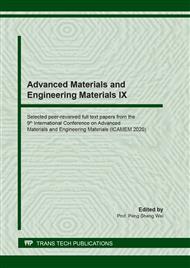[1]
C. D. Williams, U.S. Patent 6,391,941. (2002).
Google Scholar
[2]
M. Y. Amir Hashim, M. D. Moris, NR latex vulcanization-Prevulcanization and postvulcanization of dipped NR latex films. J. Rubb. Res. 2 (1999) 78–87.
Google Scholar
[3]
R. Jamrern, C. Singnoy, P. Suwanna, V. Somsongkul, A. Prajitr, R. Ditwichairut, W. Suwannarat, S. Sakdivilaiskul, The Effect of a PARA Rubber Ball Training Program on the Hand and Arm Strength and the Hand-Eye Coordination of Older Adults, J. Health. Sci. 9 (2019) 12-18.
Google Scholar
[4]
H. M. Lim, M. Y. Amir-Hashim, Polyurethane and natural rubber latex blend foam rubber. J. Rubber. Res. 14 (2011) 41-50.
Google Scholar
[5]
L. Oliveira-Salmazo, A. Lopez-Gil, F. Silva-Bellucci, A. E. Job, M. Rodriguez-Perez, Natural rubber foams with anisotropic cellular structures: Mechanical properties and modeling, Ind. Crop. Prod. 80 (2016) 26-35.
DOI: 10.1016/j.indcrop.2015.10.050
Google Scholar
[6]
A. Stevenson, W. Midlands, U.S. Patent 4,695,609. (1987).
Google Scholar
[7]
A. Stevenson, W. Bromwich, R. S. Virdi, H. Wood, U.S. Patent 5,254,635. (1993).
Google Scholar
[8]
P. Sheth, R.N. Desai, Nitrosamine Generating Accelerators in Curing of Rubber, IJSRD, 1 (2013) 529-531.
Google Scholar
[9]
P. Sheth, R.N. Desai, Replacing TMTD with Nitrosamine Free TBzTD-Accelerator in Curing of Rubber, IJSRD, 1 (2013) 532-535.
Google Scholar
[10]
R. M. Mariano, H. M. da Costa, M. R. L. Oliveira, M. M. M. Rubinger, L. L. Y. Visconte, The behavior of dithiocarbimate derivative as safety accelerator of natural rubber compounds. J. Appl. Polym. Sci. 110 (2008) 1938-1944.
DOI: 10.1002/app.28815
Google Scholar
[11]
R. Roslim, M. Y. Amir-Hashim, P. T. Augurio, Natural Latex Foam, J. Eng. Sci. 8 (2012) 15-27.
Google Scholar
[12]
S. F. Chen, W. C. Wong, C. Y. Low, U.S. Patent 9,550,906. (2017).
Google Scholar
[13]
L. Kanerva, Occupational protein contact dermatitis and paronychia from natural rubber latex. J. Eur. Acad. Dermatol. Venereol. 14 (2000) 504-506.
DOI: 10.1046/j.1468-3083.2000.00175.x
Google Scholar
[14]
S. M. Tarlo, G. L. Sussman, D. L. Holness. Latex sensitivity in dental students and staff: a cross-sectional study. J Allergy Clin Immunol. 99 (1997) 396-401.
DOI: 10.1016/s0091-6749(97)70058-7
Google Scholar
[15]
V. P. Kurup, H. Alenius, K.J. Kelly, L. Castillo, J.N. Fink, Allergy Immunol. Int. Arch. 109 (1996) 58–67.
DOI: 10.1159/000237232
Google Scholar


